|  
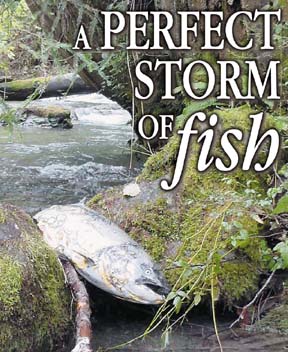
by SETH ZUCKERMAN
AFTER A STRING OF POOR SALMON RUNS, IT SEEMED LIKE THE LUCK of fish and fishermen alike had finally turned. Charter boats returned to port laden with their silvery catch. Throngs of chinook and coho swarmed up North Coast rivers and streams, and fish fans allowed themselves to hope that they had finally turned the corner to an era of renewed abundance. The year was 1987, and that year's bountiful salmon runs were followed by a slump that lasted more than a decade. As the 2001-02 salmon spawning season draws to a close, anyone who has been paying close attention -- from fisheries biologists to riverbank dwellers -- knows that North Coast runs have been about the best since the late 1980s. Observers agree that the salmon's good fortune has been due to a perfect alignment of factors that favored the fish throughout their lives. But they warn not to extrapolate too much from this year's good fortune. "It was a good year, but one year doesn't make a trend," says Humboldt State fisheries professor Terry Roelofs. No one compiles coast-wide estimates of salmon populations, so any picture of abundance has to be assembled from a host of indicators. Sportfishing boats landed more chinook, or king, salmon in Eureka during the 2001 season than in any year since 1990, according to the California Department of Fish and Game. The fish caught last summer were massing offshore in preparation for their upriver spawning runs this fall and winter.
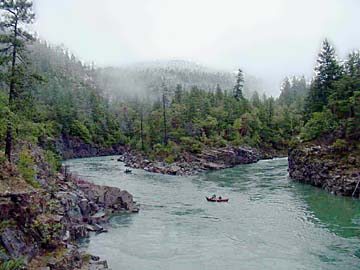 Fishing for steelhead at the Forks of Smith River. Fishing for steelhead at the Forks of Smith River.
Photo by Zack Larson
Once they entered the rivers, salmon reached fish-tallying stations in large numbers, thanks to well-timed flows that allowed them passage upstream. The egg-taking station on Hollow Tree Creek near Leggett, for instance, saw 585 chinook, several times the typical catch in its 10 years of operation. On Freshwater Creek near Eureka, the Humboldt Fish Action Council's weir intercepted more than 700 coho (or silver) salmon, says Roelofs, making it the best run since the late 1980s. Hatcheries from the Smith near the Oregon border to the upper mainstem of the Eel in northern Mendocino County report similar findings. Other data comes from stream counts in which surveyors walk rivers and creeks to count live fish, carcasses and redds -- the salmon's stream-bottom nests. Throughout the region, where conditions have made it possible to survey, the results have been encouraging. On the Smith River, Sea Grant Adviser Jim Waldvogel has been counting the spawning fish and spent carcasses on a 1.7-mile stretch of one tributary since 1980. This year's count of 361 chinook salmon is the best ever, more than double the 22-year average. In a single half-mile reach on a tributary of the Van Duzen River, Fish and Game biologist Scott Downie counted 108 live fish. During the decade since his crews began surveying that creek, a typical count has been less than 20. Simpson Timber fisheries biologist Matt House says he found more than 100 salmon in less than a mile of Ryan Creek near Eureka (mostly carcasses of spawned fish), and a week later documented 100 more. Biologist Gary Peterson from the Mattole Salmon Group puts it in more visceral terms. "The glorious smell of salmon carcasses was very prevalent this year. The 1987-88 season was the last time you could smell the carcasses before you would see them." His crews on the Mattole, too, found the best spawning populations they'd seen in more than a decade.
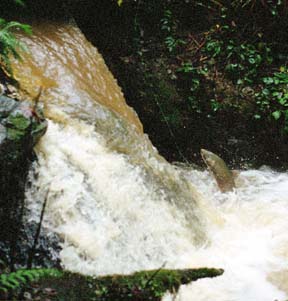 Coho salmon leaps up Morrison Gulch/Quarry Road culvert before improvements. Coho salmon leaps up Morrison Gulch/Quarry Road culvert before improvements.
Photo by Michael Love
Some of these findings can be pinned on factors besides an abundance of fish: This year's weather made them easier to count. Wet weather from mid-November through early January raised flows in area streams and provided ideal conditions for the fish to migrate upriver. The high water allowed salmon to reach their favored headwaters spawning reaches, but receded in time for surveyors to count the later fish, particularly coho, on their spawning grounds. That caveat notwithstanding, all of the clues to the size of the salmon population point in the same direction. Observers agree that this year's runs were the strongest in a dozen years -- not merely a mirage born of favorable conditions for fish census. But in a region like Humboldt County, where everything from timber harvest to local politics is intertwined with the health of the fish runs, that's far from the end of the story. North Coasters naturally try to make sense of what these increased runs might mean -- what accounts for them, and whether they are harbingers of better runs to come. Salmonologists begin by cautioning that good returns of adult fish must be seen in a larger historical perspective. "Our perceptions of abundance have been warped by having almost nothing for so many years," says Walt Duffy, head of the Cooperative Fisheries Unit at Humboldt State University. Roelofs agrees. "You have to put it in historical perspective," he says. "They used to harvest three or four hundred thousand fish from the Eel River each year. We're still talking about remnant runs." Duffy warns that this year's good runs don't constitute grounds to relax the protections offered to salmon in recent years. "I'm sure that with the return of the fish, there will be people who say that we don't need to be as careful. Some will want to use these higher numbers for nefarious purposes -- like people who have an interest in harvesting timber in riparian areas, or withdrawing water from the upper Klamath. But we need to look 50 years out, so that we don't get into this situation [of diminished runs] again." Pressed to offer reasons for the increases in this year's salmon numbers over the fish-poor 1990s, fisheries scientists and activists alike point to a fortunate constellation of favorable conditions for the fish, from the moment their parents entered the rivers to spawn, through their return to their natal rivers to complete the cycle. "These fish have had some of the best natural conditions we could hope for," says Tom Weseloh, North Coast manager for Cal Trout. "They had good rainfall when the previous generation migrated upriver, good conditions when they swam down to the ocean, good ocean conditions, and good conditions when they returned. We hit a grand slam on all of them." For much of the late '90s, salmon populations on the North Coast suffered the effects of the 1997-98 El Niño weather pattern. El Niño results in warm water on the ocean surface, which suppresses the upwelling of nutrient-rich water from deep below. Without the upwelling, the organisms at the base of the food chain grow slowly, ratcheting down the supply of food to all the creatures that depend on them directly or indirectly. The most recent El Niño ended in the spring of 1998, just as this year's 4-year-old chinook salmon reached the ocean. Since then the ocean has cooled, fecund water has percolated up from the depths and the food chain has flourished. This summer, Roelofs recalls, boats offshore would see 60-foot-thick schools of small fish on their sonar fishfinders -- herring, anchovies, needlefish and squid. For salmon, which feed on those fish, such ocean conditions amount to an aquatic smorgasbord. A favorable ocean can raise the survival rate for salmon during the ocean phase of their lives from 1 or 2 percent to 7 or 8 percent, Roelofs says.
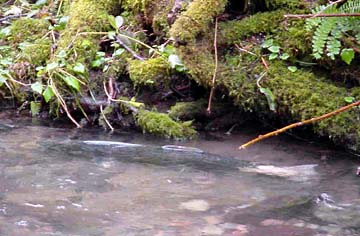 Salmon spawns at Mill Creek Salmon spawns at Mill Creek
Photo by Zack Larson
The good ocean conditions get the credit, too, for the remarkable size of many of this year's returning fish. "I have sportfished out of Trinidad for 30 years," says Roelofs, "and I can count on the fingers of one hand the number of fish over 40 pounds I've seen. Forty-pounders were common this year. It isn't that we had 5-year-old fish -- we had some exceptional ocean conditions." Naturally, a good year like this one raises hopes that more good years will follow. Unfortunately, recent experience does not bear out any connection. "It doesn't necessarily follow that big brood years beget big brood years," says Downie. He points out that the strong 1987 run was followed a few years later by disappointing returns, despite the large numbers of eggs that were deposited in area streams. And the plentiful 1987 runs were the offspring of decidedly unpromising runs in 1983-84, many of whose number had poorly developed reproductive organs, Downie recalls. Indeed, there's some evidence that an overabundance of fingerlings can actually diminish the number of returning adults, Duffy says. The more fish are competing for a given amount of food and shelter in the tributary streams, the smaller they are when they migrate to the ocean, and the less likely they are to survive. That's particularly true of coho, which rear for more than a year in fresh water before they swim down to the sea. But some observers see cause for hope in a medium-term climate shift known as the Pacific Decadal Oscillation (PDO). Unlike El Niño, which lasts a year or two, the PDO stays in place for a few decades at a time, driven by patterns in the winds that blow across the North Pacific. The oscillation favors the salmon runs of Alaska and British Columbia for a while, says Duffy, and then favors those to the south. Indeed, the catch records from salmon fisheries up and down the coast show a pattern of large catches alternating back and forth between Alaska and the lower 48 every 20 or 30 years. This cycle tipped the scales toward the northern populations from 1925 to 1946, then toward the southern ones between 1947 and 1976. In 1977, it shifted against the runs in this region, but the last couple of years have shown signs that it is returning to favor us again. That's not to say, Duffy cautions, that we can forecast 30 years of good fishing now that we have the PDO on our side. "There can still be El Niño events overlaid on top of that, and the fishing won't be so good when we get warm water from an El Niño event," he says. In fact, meteorologists at the National Oceanic and Atmospheric Administration in Seattle announced last week that another El Niño event is brewing, and may set in by this summer. If so, the ocean might offer a harsh greeting for North Coast fingerlings as they swim out to sea. In the meantime, the offspring of this year's bumper runs are developing slowly in the gravels of North Coast streams as pea-sized translucent orange eggs. Thanks to this season's ample rains, the spawners who produced them were able to get as far up in most tributaries as they would have wanted. In some cases, thanks to restoration projects or the natural processes of watershed healing, this bountiful run coincided with the opening of new streams to salmon, where this year's adults promptly spawned.
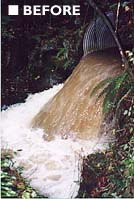 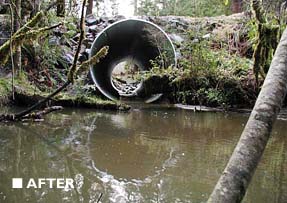
Improvements at the Quarry Road culvert. Photo on left by Ross Taylor. Photo on right by Seth Zuckerman
In Bayside, local salmonistas had noticed that a culvert under Quarry Road kept fish from reaching good spawning habitat on a tributary of Jacoby Creek. In their dismay, they staked out the site two winters ago and netted fish as they failed to make the five-foot jump from creek to culvert. These "salmon ushers" then carried the fish -- 14 coho -- across the road and released them upstream. Last summer, the county Public Works Department replaced the culvert with a larger one that rests right on the streambed. "We've seen a ton of fish upstream -- 75 adult coho in a couple of thousand feet," says fisheries consultant Ross Taylor. Opening up new habitat to fish -- or abetting the recovery of damaged habitat -- will be crucial for large runs like this year's to breed successfully and restore the abundance that used to be synonymous with salmon on the North Coast. "Without fresh-water habitat to produce smolts, salmon can't take advantage of good ocean conditions," says the Mattole's Peterson. "There's not much that can be done about El Niños and upwellings -- all we have a way of manipulating is the freshwater part of their life cycles." Seth Zuckerman, a free-lance writer, covers resource issues on the West Coast for the Tidepool.org news service. He lives in Petrolia. 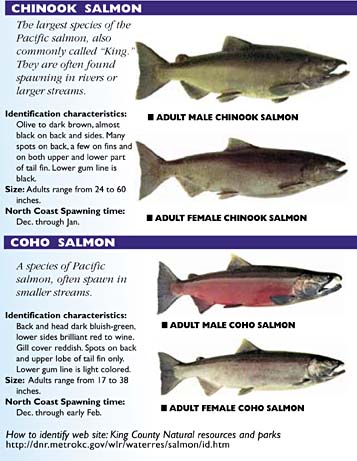 | glossary
Anadromous. A fish that spawns in fresh water and spends part of its life in salt water
Fry. Young salmon who can swim and catch their own food
Fecund water. Fertile, nutrient rich water
Hatchery. A place for hatching eggs of fish and allowing them a place to grow until they are better able to survive on their own in the ocean
Imprinting. The process through which young fry "memorize" details about their home streams. As adult spawners, they use
this knowledge to find their way back.
Milt. The milky sperm the male salmon releases to fertilize the eggs.
Redd. A salmon nest, dug out of the gravel in the stream bed by the adult female.
Smolt. Young salmon, migrating downstream from freshwater to saltwater.
Spawn. To bring forth a new generation of salmon by digging nests in the stream bed and depositing eggs and milt into them.
Weir. A fence-like fish trap placed across a stream or outlet forces fish to swim into waiting traps.
SOURCE glossary site:
Salmon from A to Z - Fairbanks North Star Borough School District, Fairbanks, Alaska www.northstar.k12.ak.us/schools/upk/chena/salmon/salmon.html |
IN THE NEWS | ELECTION 2002 | CALENDAR Comments? E-mail the Journal: [email protected] 
© Copyright 2002, North Coast Journal, Inc. | 


 Fishing for steelhead at the Forks of Smith River.
Fishing for steelhead at the Forks of Smith River. Coho salmon leaps up Morrison Gulch/Quarry Road culvert before improvements.
Coho salmon leaps up Morrison Gulch/Quarry Road culvert before improvements. Salmon spawns at Mill Creek
Salmon spawns at Mill Creek
